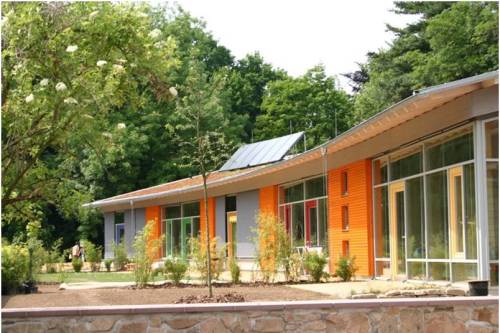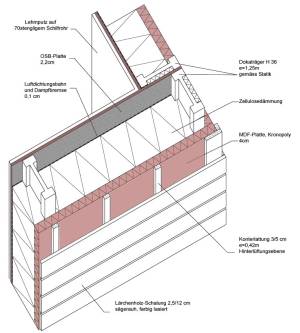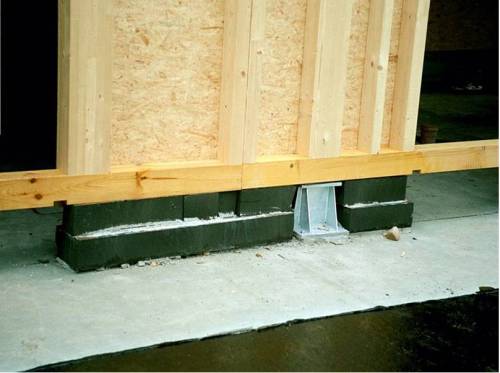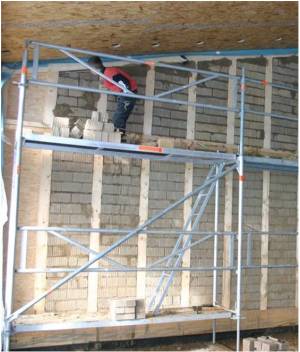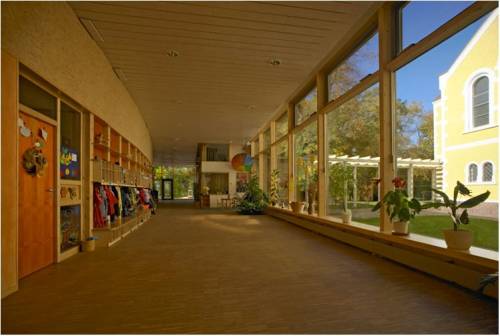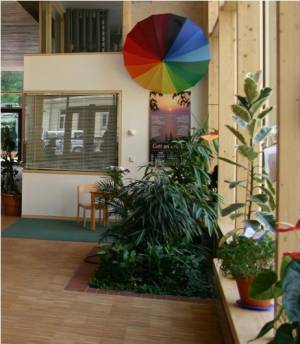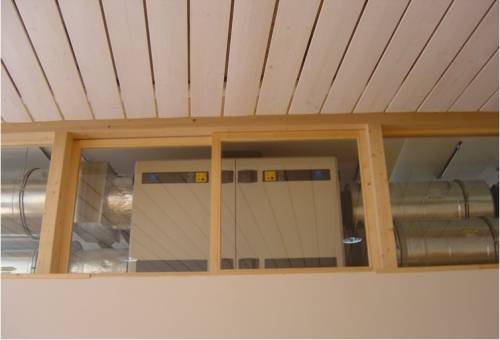Table of Contents
Playing in a Passive House - A timber/mudbrick building for children
Author: Dipl. Ing. Olaf Reiter
Reiter & Rentzsch Architects
Moritzburger Weg 67, 01109 Dresden, Germany
Tel. +49 (0)351 | 885050
architekt@reiter-rentzsch.de
A kindergarten in the cloister
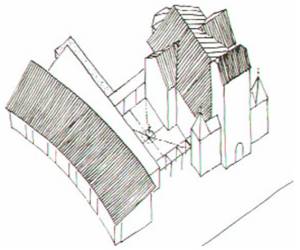 |
| The kindergarten (left), the St. Jacob’s Church (right) and the inner courtyard which connects the two buildings. |
The Lutheran church community has built a new kindergarten directly next to the St. Jacob’s Church in Döbeln, Germany. The St. Florian Kindergarten forms a structural unit with the church, both buildings are connected by a covered walkway with an inner courtyard, similar to a cloister. After the River Mulde flood in 2002, a replacement building needed to be built and Reiter and Rentzsch Architects won the architectural competition. The modern colourful timber construction stands proudly next to the 19th Century church, both enhance each other in their effect. When entering the single storey kindergarten from the street, the eyes are constantly drawn towards the northern glass façade which offers a clear view of the church. The curving crimson-varnished mudbrick wall with built-in coat racks separates the hall from the group rooms situated on the southern side. Large doors with side panels of glass lead to the children’s play rooms with their own wooden galleries and washrooms. The 68 nursery and pre-school children have direct access to the garden from each of the 4 group rooms. The pleasant smell of wood and clay pervades the rooms thanks to the construction method using safe building materials and to the controlled ventilation system which is located visibly behind a glass wall above the auxiliary rooms on the northern side. The ecological Passive House concept is very well accepted by the clients and the children.
Timber-frame construction with formwork beams
All external walls and the roof are timber frame constructions with 36cm wooden I-beams (Doka-formwork beams, centre distance 1.25cm) reinforced with OSB boards and completely covered with a 4cm soft-wood fibreboard to ensure the absence of thermal bridges. The wall construction including the cellulose insulation has a U-value of 0.11 W/m²K and, upon approval, meets F30-B construction requirements. As wood constitutes a thermal bridge in Passive House constructions, the use of wood at the corners of the building was minimised (see drawing). The floor slab was insulated on the underside, making it a warm component (U=0.13 W/m²K). In addition, the whole timber construction rests on foam glass struts in order to protect the base that is structurally vulnerable by lifting it above the floor construction.
The interior walls of the group rooms are timber frame walls with solid wood profiles, which were hand-filled with mudbricks by the children and their parents. 70-stemmed reed, wall surface heating and loam rendering with diffusion-permeable casein paint round off the wall construction. The clay provides for a large thermal mass in the building and a constant level of indoor air humidity.
The gallery and auxiliary room ceilings are solid wood ceilings of flat laminated wood beams. A Passive House triple-glazing system (U=0.85 W/m²K, g=55%) was screwed onto the supporting timber structure. The weather shell of the house is formed by colour-varnished larchwood planking on the walls, a rear-ventilated green roof and wooden windows with screening material for shading. The use of sheeting was deliberately avoided in the timber construction, thus making the wall and roof components progressively diffusion-permeable from the inside towards the outside. The airtightness was verified by means of a blower door test and the very first measurement gave an n50 value of 0.5 1/h (based on the interior volume).
The timber construction was pre-fabricated in the factory, complete with windows, and was assembled in two weeks. The highly accurate pre-fabrication and design quality satisfied the clients. Therefore the erection of the timber construction in winter did not pose a problem.
60% glass facade on the north-facing side – is that possible?
In a Passive House, the largest glazing area normally faces south as most of the solar gains can be achieved in this way. As the view of the adjacent church was such an important feature, the architects decided in favour of an additional glass facade on the north-facing side. The initial PHPP calculations resulted in a heating demand slightly higher than the 15 kWh/m²a limit.
The Passive House criteria were met by installing a closed parapet, reducing the glazed area and improving the insulation of all external walls. After a year of use, it became obvious that a Passive House can function well even under these general conditions for urban planning.
Indoor plants counteract excessively dry air
A child needs about 15m³/h of fresh air. Because of the very high occupation level (2.5m² per child) 300m³/h of fresh air are required in a group room for 18 children and an adult. For a room volume of 185 m³ this gives an air change rate of 1.6. This can lead to very low air humidity levels in the rooms in winter. In cooperation with Mr. Frantz of the Botanical Gardens in Tübingen, a concept for improving the air humidity using indoor plants was developed, as these are ideal humidifiers. A plant that is 2m high (Ficus alii) can release 1.5 litres of water into the surrounding air in 24 hours. Two large planting beds were created in cutouts in the floor slab. A 20cm layer of clay was inserted to provide windtightness towards the ground. The substratum is a special mixture of expanded clay, peat and clay granules. The plants originate from the tropical rainforests; one planting bed is modelled on the African rainforest, the other on the Asian rainforest. The children water the plants themselves and are thrilled with how fast these plants grow.
Building services
In a Passive House, the basic energy supply is provided mainly by the internal sources (persons, lighting etc.) and by the solar gains through the windows facing south. As a decrease in the indoor temperature can occur after weekends and holidays etc. due to the lack of internal heat sources, an additional heat supply is necessary for the kindergarten. In order to meet the ambitious energy requirements for the building, solar heat from solar collectors and local heat from the existing low-temperature gas boiler system of the St. Jacob’s Church are used.
The heat is distributed to group rooms through wall heating surfaces consisting of diffusion-tight metal composite pipes which have been laid in loam rendering. This leads to pleasant radiant heat over a large area and there is no need for separate heaters.
The ventilation system is designed to operate with minimum energy use. This is achieved through heat recovery from the exhaust air by means of a rotation heat exchanger that heats the outdoor air, and by restricting the air changes to the minimum fresh air rate required per person. In addition to the heat recovery, a hygroscopic coating on the heat exchanger also allows moisture recovery from the air. In this way, together with the plants, it is possible to maintain the minimum acceptable level of air humidity in the room even on very cold winter days with an extremely low water content of the outdoor air. Furthermore, the outdoor air quality can be improved by using fine filters (to prevent pollen being carried in). The air is distributed by means of a duct system and is carried into the group rooms and the multifunctional room via nozzle outlets. Air is drawn off through the lobby as well as the adjacent areas including the staff rooms, auxiliary rooms and the washrooms by air transfer elements in the galleries. The Passive House project nearly failed du to the fact that in the school construction directive of the State of Saxony calls for natural ventilation. The concept was saved by the confirmation that natural ventilation through windows is ensured at all times and is only assisted by the controlled ventilation with heat recovery.

